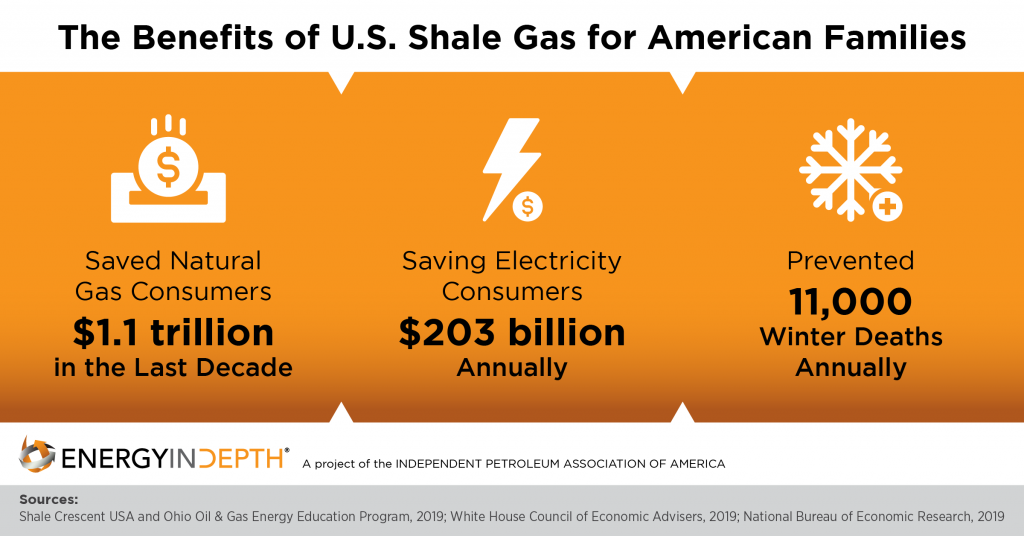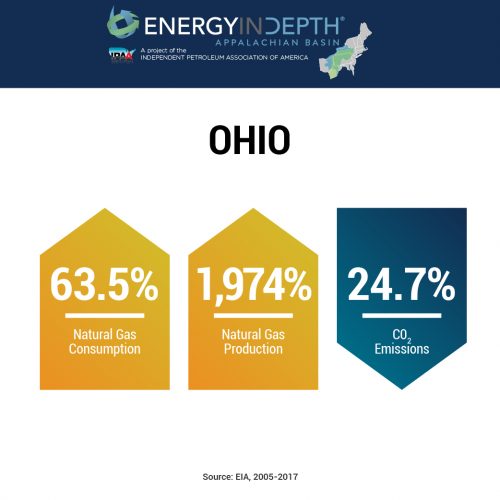While President Trump and former Vice President Biden have visited the Appalachian Basin numerous times this election cycle, this week’s debate in Cleveland, OH will mark the first time the pair shares the stage to talk about the biggest issues facing our country today.
The Shale Revolution has been a game-changer for the region where the first presidential debate will take place. If the Appalachian Basin – Ohio, Pennsylvania and West Virginia – were a country, it would be the third largest natural gas producing country in the world. Not only has this prolific development been a boon for these states’ economies over the last decade in the form of family-sustaining jobs, investments and tax revenue, but it has also helped expand accessibility to natural gas in the region, deliver energy savings and cleaner, healthier air.
The Basics
-
- The Appalachian Basin comprises the Marcellus and Utica/Point Pleasant shales.
- Led by production in Pennsylvania (19.1 billion cubic feet per day), the Appalachian Basin produced 1 bcf/d in 2019 – or 11.7 trillion cubic feet of natural gas. That’s about 29 percent of total U.S. natural gas production in 2019, and more than every natural gas producing country in the world except the United States and Russia.
- That’s enough natural gas produced in the Appalachian Basin – every, single day – to power 780,511 houses – or two homes for every person living in Cleveland – for a year.
- While there is steady oil production in the region – combined production for the three states was about 136,000 barrels per day in June 2020 – it is predominantly a natural gas play.
- The Appalachian Basin was responsible for 85 percent of total U.S. natural gas production growth from 2008 to 2018.
Economic Prosperity
- Shale development has brought good-paying jobs to the region, and these jobs go far beyond the well head. In Ohio, for instance, the upstream, midstream, and downstream sectors of the natural gas and oil industry supports more than 200,000 jobs, which have an average annual salary of $83,000 ($32,000+ higher than average U.S. salaries across all industries), according to a recent Ohio Department of Jobs and Family Services analysis.

- Shale development has also brought significant investments to the region. Direct upstream, midstream and downstream investment in Ohio is estimated to be around $83 billion since 2011.
- An abundance of natural gas is fueling new and continued manufacturing investments, as well as attracting a growing petrochemical industry. Royal Dutch Shell’s $6 billion petrochemical complexcurrently supports approximately 6,000 construction jobs, and will permanently employ about 600 full-time workers at its location in Beaver County, Pa. And Belmont County, Ohio’s proposed PTT Global ethane cracker plant is expected to be a roughly $10 billion investment, that will employ hundreds of skilled labor positions, and generate millions in added tax revenue and school funding annually.

- Natural gas-fired power plants are being built across the Appalachian Basin, bringing significant jobs and revenue. More than $25 billion is being invested in building these new facilities to replace aging plants, which is helping to lower both energy bills and emissions.

- Shale development is also bringing needed tax revenue to local communities. Eight of Ohio’s top Utica Shale development counties collected more than $141.9 million in real estate property taxes on oil and natural gas production from 2010 to 2017. In Pennsylvania, the state’s impact tax – which benefits all 67 counties, especially communities with shale development – has generated $2 billion since 2011.

Affordable Energy
- Consumers are benefiting from shale development, as an abundance of natural gas has helped lower natural gas and electricity costs. Ohio, Pennsylvania and West Virginia’s natural gas consumers saved more than $80 billion from 2006 to 2016. Pennsylvania’s residential natural gas prices are 56 to 76 percent lower than 2008, with families realizing average annual savings of $1,100 to 2,200 per household.
- Nationally, the growth in U.S. natural gas production, driven by the Appalachian Basin, has saved natural gas consumers $1.1 trillion over the last decade and is estimated to save electricity consumers approximately $203 billion annually.

Improving the Environment
- Water intensity for power generation – the average amount of water withdrawn per unit of total net electricity generated – decreased nearly 14 percent from 2014 to 2018 thanks to natural gas power plants replacing aging facilities.
- Natural gas-fired power plants are also helping lower emissions. Since 2005, Ohio has reduced its emissions by more metric tons of C02 than any other state in the country – state emissions declined by 67 million metric tons between 2005 and 2017.

- Pennsylvania was able to achieve its Clean Power Plant goals years ahead of schedule, which the state’s top environmental regulator attributes is “primarily because of the shift toward cleaner natural gas.” The state’s CO2 emissions from power generation have declined 36 percent since 2010 and other critical air pollutants (SOx, NOx, PM2.5 and VOCs) have also seen significant decreases, as natural gas became the state’s second largest electricity generation source.

As elected officials in the Appalachian Basin have recognized time and again, the availability of affordable, reliable energy is not a partisan issue – and here in Appalachia, shale is delivering just that. Check out EID’s latest infographic to learn more.

This post appeared first on Energy In Depth.
